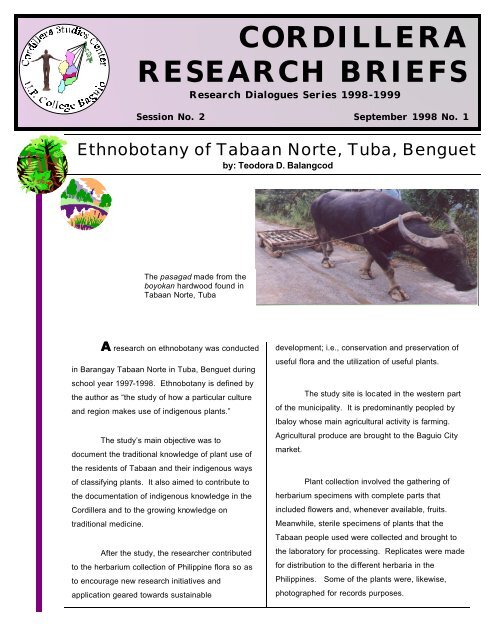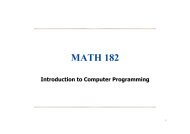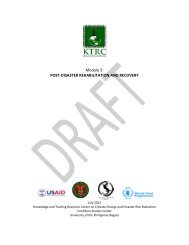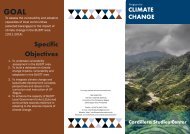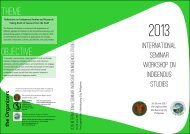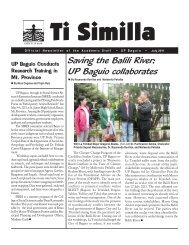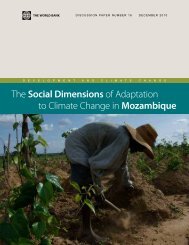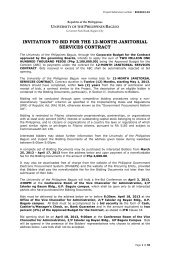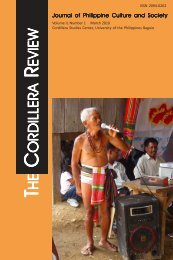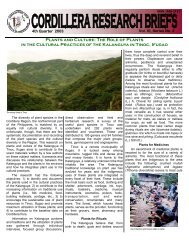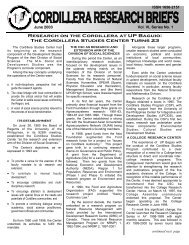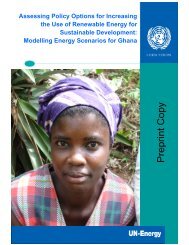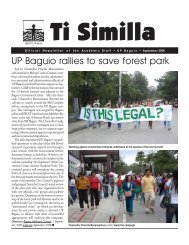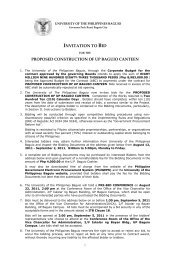Research Brief Sept 1998-1 - Cordillera Studies Center
Research Brief Sept 1998-1 - Cordillera Studies Center
Research Brief Sept 1998-1 - Cordillera Studies Center
You also want an ePaper? Increase the reach of your titles
YUMPU automatically turns print PDFs into web optimized ePapers that Google loves.
CORDILLERARESEARCH BRIEFS<strong>Research</strong> Dialogues Series <strong>1998</strong>-1999Session No. 2 <strong>Sept</strong>ember <strong>1998</strong> No. 1Ethnobotany of Tabaan Norte, Tuba, Benguetby: Teodora D. BalangcodThe pasagad made from theboyokan hardwood found inTabaan Norte, TubaA research on ethnobotany was conductedin Barangay Tabaan Norte in Tuba, Benguet duringschool year 1997-<strong>1998</strong>. Ethnobotany is defined bythe author as “the study of how a particular cultureand region makes use of indigenous plants.”The study’s main objective was todocument the traditional knowledge of plant use ofthe residents of Tabaan and their indigenous waysof classifying plants. It also aimed to contribute tothe documentation of indigenous knowledge in the<strong>Cordillera</strong> and to the growing knowledge ontraditional medicine.After the study, the researcher contributedto the herbarium collection of Philippine flora so asto encourage new research initiatives andapplication geared towards sustainabledevelopment; i.e., conservation and preservation ofuseful flora and the utilization of useful plants.The study site is located in the western partof the municipality. It is predominantly peopled byIbaloy whose main agricultural activity is farming.Agricultural produce are brought to the Baguio Citymarket.Plant collection involved the gathering ofherbarium specimens with complete parts thatincluded flowers and, whenever available, fruits.Meanwhile, sterile specimens of plants that theTabaan people used were collected and brought tothe laboratory for processing. Replicates were madefor distribution to the different herbaria in thePhilippines. Some of the plants were, likewise,photographed for records purposes.
<strong>Cordillera</strong> <strong>Research</strong> <strong>Brief</strong>sThe buybuy, a perennial grass whoseinflorescence and stalk are used in making broomsAn ocular inspection of the site showed that thevegetation in Tabaan Norte is generally different compared topine forest formations seen in Baguio City and nearby places.The trees are broad-leaved, and most of these belong to familyMoraceae. Specific mention was made of the samak tree,particularly its blossoms which are used by the people toferment basi, a local wine. Shrubs grow in abundance in thearea and some of the undershrubs have been identified torepresent liana and other grasses. Liana belongs to thePassifloraceae family and these “hang beautifully on trees andother plants.” Fern species not commonly seen in other places,likewise, abound in the area.The ethnobotanical data collected around Tabaan Nortewere classified into several categories, namely food and spices,medicinal plants, for construction, for livelihood projects, fortreatment of snakebites and dogbites, and ornamental plants.Certain plants were, likewise, identified as ritual plants and asamulets and for driving away evil spirits. Not included in thestudy were plants found in the forests of Tabaan Norte.A total of 15 different plants were collected andcatalogued. The research generated the local names of theplants and gave a brief description of each and their local uses.In terms of botanical description, the scientific names and thefamily to which each species is classified were also identified.Prepared by: Alice G. FolloscoThis special folio of CORDILLERA RESEARCH BRIEFScarries an abstract of the research paper that forms partof the <strong>Research</strong> Dialogues Series of <strong>1998</strong>-1999. It ispublished by the <strong>Cordillera</strong> <strong>Studies</strong> <strong>Center</strong> to disseminate itsresearch results to a wider audience.The views expressed in this publication are those of the author anddo not necessarily reflect those of the <strong>Cordillera</strong> <strong>Studies</strong> <strong>Center</strong>.Design & Lay -out: Marion DifuntorumDesk Study Editor: Mary Ann J. Ladia©2000 by <strong>Cordillera</strong> <strong>Studies</strong> <strong>Center</strong>All rights reserved. Published 2000For further information on this study, please contact:The Director<strong>Cordillera</strong> <strong>Studies</strong> <strong>Center</strong>UP College Baguio2600 Baguio CityTel/Fax (63) (74) 442-57-94Tel. Nos. (63) (74) 442-34-84 loc. 104


